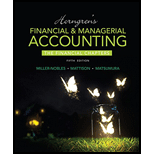
Concept explainers
Comparing amounts for cost of goods sold, ending inventory, and gross profit-FIFO and LIFO
Assume that Toyland store bought and sold a line of dolls during December as follows:
| Dec. 1 | Beginning merchandise inventory | 11 units@ $ 8 each |
| 8 | Sale | 6 units@$ 21 each |
| 14 | Purchase | 17 units@$ 15 each |
| 21 | Sale | 15 units @ $ 21 each |
Requirements
1. Compute the cost of goods sold, cost of ending merchandise inventory, and gross profit using the FIFO inventory costing method.
2. Compute the cost of good s sold, cost of ending merchandise inventory, and gross profit using the LIFO inventory costing method.
3. Which method results in a higher cost of goods sold?
4. Which method results in a higher cost of ending merchandise inventory?
5. Which method results in a higher gross profit?
Want to see the full answer?
Check out a sample textbook solution
Chapter 6 Solutions
Horngren's Financial & Managerial Accounting, The Financial Chapters Plus MyAccountingLab with Pearson eText -- Access Card Package (5th Edition)
- overhead application ratearrow_forwardTotal costs were $77,400 when 30,000 units were produced and $90,900 when 36,000 units were produced. Use the high- low method to find the estimated total costs for a production level of 32,000 units.arrow_forwardallocated utility cost for a batch of muffins isarrow_forward
 Cornerstones of Financial AccountingAccountingISBN:9781337690881Author:Jay Rich, Jeff JonesPublisher:Cengage Learning
Cornerstones of Financial AccountingAccountingISBN:9781337690881Author:Jay Rich, Jeff JonesPublisher:Cengage Learning Financial Accounting: The Impact on Decision Make...AccountingISBN:9781305654174Author:Gary A. Porter, Curtis L. NortonPublisher:Cengage LearningPrinciples of Accounting Volume 1AccountingISBN:9781947172685Author:OpenStaxPublisher:OpenStax College
Financial Accounting: The Impact on Decision Make...AccountingISBN:9781305654174Author:Gary A. Porter, Curtis L. NortonPublisher:Cengage LearningPrinciples of Accounting Volume 1AccountingISBN:9781947172685Author:OpenStaxPublisher:OpenStax College Financial AccountingAccountingISBN:9781337272124Author:Carl Warren, James M. Reeve, Jonathan DuchacPublisher:Cengage Learning
Financial AccountingAccountingISBN:9781337272124Author:Carl Warren, James M. Reeve, Jonathan DuchacPublisher:Cengage Learning Intermediate Accounting: Reporting And AnalysisAccountingISBN:9781337788281Author:James M. Wahlen, Jefferson P. Jones, Donald PagachPublisher:Cengage Learning
Intermediate Accounting: Reporting And AnalysisAccountingISBN:9781337788281Author:James M. Wahlen, Jefferson P. Jones, Donald PagachPublisher:Cengage Learning Financial And Managerial AccountingAccountingISBN:9781337902663Author:WARREN, Carl S.Publisher:Cengage Learning,
Financial And Managerial AccountingAccountingISBN:9781337902663Author:WARREN, Carl S.Publisher:Cengage Learning,





